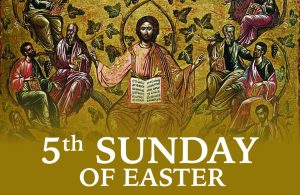 Our Gospel reading is taken from the middle of the Last Supper discourse when Jesus speaks about his relationship with his disciples – with each of us. He teaches about the importance of the words He has taught and how he will remain with his disciples, with us. Jesus promises to remain in a vision rich in intimacy that is profound and personal.
Our Gospel reading is taken from the middle of the Last Supper discourse when Jesus speaks about his relationship with his disciples – with each of us. He teaches about the importance of the words He has taught and how he will remain with his disciples, with us. Jesus promises to remain in a vision rich in intimacy that is profound and personal.
He uses an example to which His followers can easily relate to – fruit of the vine ripening for harvest. He knew the details of pruning and removal of non-fruit bearing branches, throwing out and burning withered branches. The people had asked him before to speak literally and not be so subtle. When He spoke about vineyards the people of Judea knew what he was talking about. It was their cash crop, not like grain which were raised purely for consumption.
He could have chosen any number of crops. However, I am glad He was attracted to the vineyards. I like the ring “I am the vine, you are the branches.” Imagine if he had used figs or olives, melons or cucumbers – I am a tree, you are the fig, the olive, the melons. The metaphor of the vine and the vine dresser made me curious about hidden symbolism beyond the obvious fact that the twigs are connected to the blossoms; the blossoms to the branches and the branches; to the vine, the vine to the root.
Grapes are one of the most ancient crops known to humans. The form to which the grape vines are trained is limited only by the grower’s imagination and the vines-in-training themselves. They must be pliant enough to yield to the contour God is shaping.
Grapes are sold as rooted cuttings. Care must be taken to ensure that the cuttings are planted right-side up. Growers are advised to plant the vines in clearly marked rows in a north-south orientation to capture the most sunlight. When the weather is cooler up to 90% of new growth is removed and young vines are typically not permitted to bear fruit for the first three years.
The pruning process reminds me of what we do every Lent. We monitor our spiritual life to remove unwanted growth, pull and discard weeds, and through our resolutions we water fledging efforts to be strong Christians – good community members – worthy disciples. Preventive action offers the greatest benefit in controlling the spread of disease from vine to vine. Visit the vines often, screen cuttings for good potential, prune as needed, dispose of dead and diseased parts, rake the soil, scout for insects.
So, what are the “Big Five” community fungal diseases? The Benedictine Mark Scott (our retreat director in 2016) suggests the big sins for Benedictines are forgetfulness, murmuring, laziness, resentment and neglect. These, he says, are the things that damage relationships, complicate things, create chaos, instill mistrust and generally disturb the peace.
How can we prevent or combat the monastic fungus? Benedict gives us 72 tools for a holy life. Surprisingly he does not start with prayer but with very basic tools that promote healthy relationships: love of God, self and your neighbor. In Chapter 4 of the Rule you can see that Benedict was intent on his followers being transparent, peace-loving, self-controlled, humble and willing to grow and change. And he says you don’t need to look beyond the walls of the monastery. You will have plenty of opportunities in community to be shaped, pruned and coaxed, like the grape vines, upward into the sunlight, which is Christ, the divine vine-grower.
As we advance in the way of monastic life, we come to recognize more keenly the intimate, loving, shaping influence of God which is the heart and core of our commitment. Like wild vines, we may stumble around reaching for false sources of sunlight, maybe even seeing only glittering reflections of light on the ground. Too often we may trudge along with our heads down looking at where we have been rather than where the divine Vine Dresser is gently training our spirits to look upward – gracing us to see beyond our dreams.
~Reflection by Sister Roberta Bailey, OSB
Have a pleasant week!


Leave a Reply